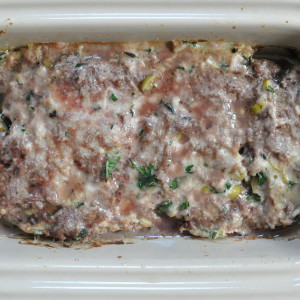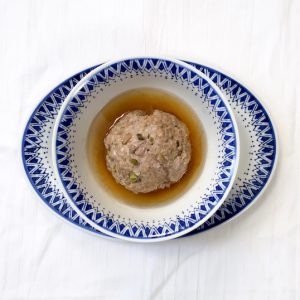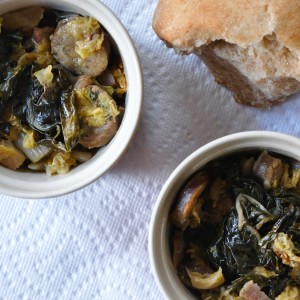Italian Meatloaf II
Italian Meatloaf II, so called because the SEO choked on any other name, comes to us from Sophie Grigson’s A Curious Absence of Chickens.
(Italian Meatloaf I appears here)

What makes a meatloaf Italian and not, say, Croatian or Welsh? A search of my Italian cookbooks gave no answers. Meatloaf recipes themselves were scant; only Edward Giobbi and Eugenia Bone’s Italian Family Dining offers a recipe. It is strikingly similar to Sophie Grigson’s.
(Meatballs are another story. But today we’re talking meatloaf.)
—
A word on nomenclature. “Meatloaf” appears as one word in numerous cookbooks and as two, i.e., “meat loaf” in others. This is a question of publisher house style. Grigson–or her publishers–opt to spell meatloaf as one word, so I am following suit. Anyone taking umbrage is asked to put away their Strunk and White now.

—
Returning to our post.
A Curious Absence of Chickens chronicles Grigson’s 2019 move from London to Italy, complete with recipes. Grigson is a warmly engaging writer whose prose edifies even as it amuses. There may be few chickens, but recipes like Orecchiette al Primitivo di Manduria–Oriccheitte with Red Wine and Meat Balls–or Polpette di Pane–that’s Bread and Cheese Fritters–more than compensate.

Having said all this, I confess my Italian meatloaf departs significantly from Grigson’s. Read on.
—
Wanna win a food photo contest? Take a picture of a pomegranate. Or an eggplant. Better yet, find some yourself a nice bunch of rhubarb.

My point? Food photo contests prefer purple or pink foods.

Fresh pistachios.
Meatloaf, on the other hand, be it Italian or American or Litvak, is some of the brownest, ugliest food around. It won’t win a single contest.
Delicious? You bet. Photogenic? Hell, no. I mean, I tried. But there is no such thing as a pretty meatloaf picture.

Many were the attempts.
Moving right along.
The old bread I used was so very old it refused to soften in the milk. A rinse in warm water helped.

Grigson’s recipe calls for firm mozzarella or scamorza, which is runnier. I used small balls of fresh mozzarella, called Bocconcini, and grated parmesan, because that’s what I had in the house. All was well.

Canadian bacon stood in for mortadella. The photographs were lousy, so here is some garlic, which also went into the mix.

Grigson’s recipe calls for roughly 2 pounds (800 grams) meat, ideally a mixture of beef and veal. Having neither, I used ground pork with great success.
As noted, the meatloaf will appear damp and unappetizing both before and after baking. Don’t worry. Once it’s out of the oven, the meatloaf will find itself, and pleasantly surprise you by being delicious.

Serve Italian Meatloaf II with roast potatoes, as Ms. Grigson does, or serve it American style, as I do. By American style, I meana bottle of catsup and a big pile of french fries.

Some people (my husband, for example) like mustard with their meatloaf. For them, serve the mustard of choice. A salad is always a good idea. Whatever you do, remember to save a slice of meatloaf for tomorrow’s lunch: a cold meatloaf sandwich.

Italian Meatloaf II
Please read notes, below, before cooking
Adapted from Sophie Grigson’s recipe for Polpettone Ripieno, which appears in A Curious Absence of Chickens
Prep time: about 15 minutes of hands-on work, and about an hour for the meatloaf to bake.
Serves: 2, easily scaled upward
approximately 35 ounces/10 grams mozzarella cheese
6 tablespoons/generous 1/3 cup milk (add more if necessary)
2 ounces/60 grams stale bread, crusts included
2 teaspoons salted or brined capers, rinsed and roughly chopped
1-2 garlic cloves, peeled and finely minced
2 large eggs
2 ounces/60 grams Canadian bacon or ham, finely chopped
1 tablespoon/30 grams freshly ground Parmesan cheese
approximately 2 tablespoons fresh parsley (optional)
1 pound/454 grams ground pork
Salt and pepper
Preheat the oven to 325F/160C
If the mozzarella is packed in whey, roll the cheese in paper towels or a clean, non-linting dish towel to expel any lingering moisture. Slice cheese into 5-6 evenly sized pieces. If using Bocconcini-type mozzarella-that is, small balls of fresh cheese–halve 5-6 balls. Set aside.
Pour milk into a smallish bowl. Tear bread into pieces and add to milk. Allow to soak.
Rinse capers in a small strainer. Tip into a clean dish towel–your used mozzarella cheese towel is fine-or paper towel. Gently pat capers dry. Roughly chop and place in large mixing bowl.
Peel and mince garlic. Add to caper bowl.
If you are a confident egg cracker, crack directly into the large bowl. If you are like me–lacking confidence–crack eggs in a separate bowl–no need to blend–and add to garlic and capers.
Returning to the bowl of milky bread: pour any leftover milk into the big bowl, leaving the soggy bread behind. You want uneven bits and pieces of bread, so tear the milky bread up a bit more if necessary. Soften resistant pieces of bread under running water. Squeeze dry. Now add to the big bowl.
Add Canadian bacon, Parmesan cheese, parsley, if using, and ground pork to bowl. Add a very little salt–the capers, Parmesan, and Canadian bacon are very salty. Be generous with the pepper.
Mix meatloaf ingredients with a large spoon or your very clean hands.
Pack half the meatloaf mixture into a 9inch/22 cm loaf pan (or comparably sized roasting pan). Now add the mozzarella, placing the cheese slices in a line down the middle of the meatloaf. Pack the remaining meatloaf mixture on top. I added a few basil leaves for decorative purposes, but I have a madly growing basil plant in my yard. This is optional.
Bake the meatloaf for about an hour. It’s done when an instant-read thermometer shows temperatures of 160F/70C. No thermometer? Meatloaf will look and smell done. Cut into it if you aren’t sure. My only case of food poisoning was self-inflicted and came from eating undercooked meatloaf. I was a young and inexperienced cook. Don’t be me.
Serve Italian Meatloaf II as Sophie Grigson does, with roast potatoes, or do as Americans do: plonked down on the table with catsup and (frozen! gasp!) french fries. A salad never goes amiss.
Meatloaf, Italian or otherwise, keeps in the refrigerator up to five days, or may frozen up to three months.
Notes:
Meatloaf is often prepared using a mixture of meats, including ground beef, veal, or pork.
The mozzarella may be replaced by another cheese; Grigson suggests scamorza or smoked mozzarella.
The raw meatloaf mixture will seem hopelessly damp. Don’t fret; it will firm up.




